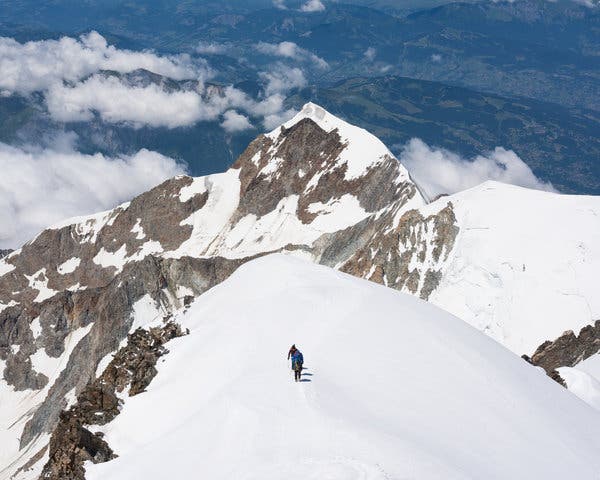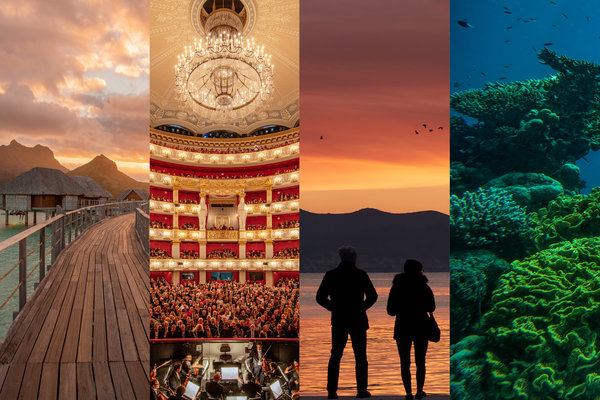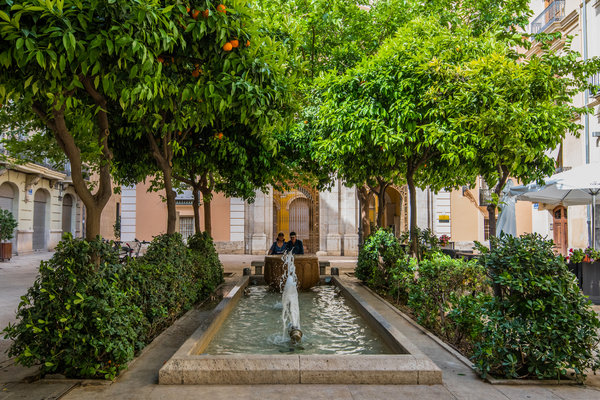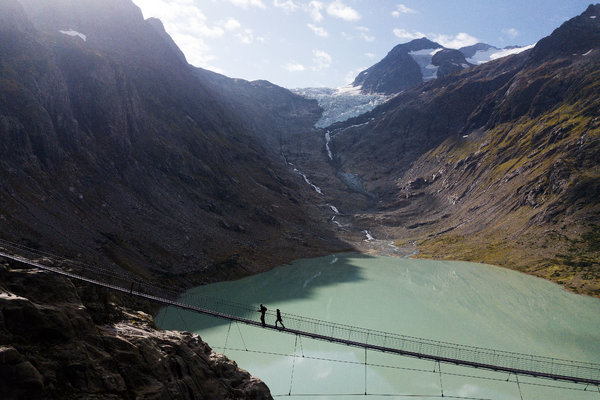The Goûter Refuge — a futuristic structure that clings to a cliff at 12,516 feet — is, for many people, the final stop en route to the top of Mont Blanc, the highest mountain in Western Europe, straddling the border between France and Italy.
Every summer at least 20,000 people attempt the 15,776-foot summit. The majority spend a night in the Goûter Refuge, on the French side, which welcomes climbers from late May through September. Local officials and guides say the number is growing, and that today’s climbers are less experienced, even as warmer temperatures are increasing the risk of rockfall and transforming once-snowy ridges into treacherous sheets of ice. A small number of climbers also appear to be unwilling to respect the rules — or even pay for their accommodation.
“People would say, ‘You have to let us stay for free. We don’t have to pay because you’re a mountain hut,’” said Antoine Rattin, 46, a guide and the manager of Goûter Refuge, recalling a few encounters last summer.
In the high, wild landscape around the Refuge, turning people out for the night could mean death, so Mr. Rattin had no choice but to abide their presence — even if that meant accepting their refusal to pay the €65.80 (about $74) fee for a bed, and exceeding the hut’s official capacity of 120 people.
Mr. Rattin’s challenges are emblematic of the mountain’s more fundamental problem, a challenge that is also afflicting Mount Everest: overcrowding, which is exacerbating the dangers posed by climate change and inexperienced climbers. This summer, local authorities are tackling these issues, and their efforts are leading to some changes for visitors.

CreditNicolas Blandin for The New York Times
The roof of Western Europe
For more than 200 years, Mont Blanc has been luring climbers. The first to reach the mountain’s white, windblown summit were Jacques Balmat, a hunter and crystal collector, and Gabriel-Michel Paccard, a doctor and botanist. The two men, both locals, made it to the top early on the evening of Aug. 8, 1786, a moment that many have cited as the birth of modern mountaineering.
Over the next few decades, a small but growing number of mountaineers and explorer-scientists followed in their footsteps. As Mont Blanc grew in fame, so too did the valley below. Hotels sprang up in Chamonix, the village at the mountain’s base, and a parade of famous visitors — Alexandre Dumas, Napoleon III, Victor Hugo, Goethe — raised the area’s profile even further. By the end of the 19th century, tourism was driving the economy.
Today, the narrow Chamonix valley attracts 4.3 million visitors a year. People come in winter to ski and snowshoe, in summer to rock climb, hike and mountain bike, or at any time of year just to wander through town and admire the views of the jagged, ice-crusted peaks. But for many visitors, getting to the top of Mont Blanc is the most powerful draw.
“Clients tend to be obsessed with this mountain, and every experienced mountaineer wants to climb it as well,” said Blaise Agresti, an independent mountain guide and the former head of the PGHM of Chamonix, the security and rescue service that responds to emergencies on Mont Blanc and the surrounding peaks. “Today, many people who come to the mountain go up, come back down and then never go back for the rest of their lives,” he said. “We’ve been marketing Mont Blanc for two centuries. We’ve sold it as this beautiful, symbolic dream. So today, this is the situation we inherit.”
Routes and risks
But the dream comes with its own set of dangers. More than half a dozen routes lead to Mont Blanc’s summit, but just two — the Three Mountains Route, which starts from Chamonix, and the Normal Route, which starts from the neighboring community of Saint-Gervais — are accessible to climbers with only a moderate amount of experience. While the majority return from the summit unscathed, both itineraries entail risk.
The Normal Route — chosen by about three quarters of the climbers aiming for the summit — goes across the Grand Couloir, a steep, narrow gully that acts as a sort of bowling alley for falling rocks. Near the top, the path leads onto a narrow ridge of snow and ice, about 100 yards long and just a couple of feet wide, that’s flanked by steep drops. If you stumble there, you can fall to your death.
Alternatively, the Three Mountains Route, a more technical itinerary that accounts for most of the remaining quarter of climbers, goes below a series of towering ice cliffs that occasionally — and very unpredictably — slough off enormous quantities of snow and ice onto the path below. Both routes are threatened with avalanches, and both cross glaciers laced with crevasses: yawning gaps in the ice that can swallow climbers whole.

52 Places to Go in 2019
A starter kit for escaping into the world.
“I did it once but I would never, ever do it again,” said Rachel McKee, 41, an Irishwoman living in France who climbed Mont Blanc six years ago. She was completely exhausted by the climb, despite her thorough training, and she had to sprint across the Grand Couloir as rocks fell around her. “It was a fantastic experience, but you’re playing with death,” she said.
An analysis of accidents along the lower portion of the Normal Route found that, between 1990 and 2017, 102 people had died between the Tête Rousse Hut and the Goûter Hut, a stretch that takes most people about three hours to hike. The biggest causes of death were falls, being hit by a falling rock, and “stranding” — getting lost or caught in bad weather. Of the 387 accident victims who needed emergency services, 84 percent were amateurs unaccompanied by a professional guide.
“If you add up the accidents on the two itineraries, you find that half of all mountaineering accidents in France happen on Mont Blanc,” Mr. Agresti wrote in a book on mountain rescue. More than half of those accidents occur on the climb to the Goûter Hut, a stretch of trail that Mr. Agresti called “one of the black spots in the Alps.”
To reduce their risk, guides say, climbers need specific skills: In addition to being fit enough to endure hours of tough hiking at high altitudes, Mont Blanc aspirants should also be confident walking in crampons. (A number of fatal falls have resulted from people tripping while wearing their just-purchased crampons.) They should also know how to walk roped together with other climbers; how to get out of a crevasse; how to interpret a mountain weather forecast; and how to gauge snow and rock conditions.
Anyone short on these skills should hire a professional guide; the Compagnie des Guides de Chamonix, the official association of Chamonix’s professional mountain guides, is a good place to start. Visitors will pay between €900 and €1,500 for a guided trip for two people to the summit, in addition to the cost of gear, hut accommodation and a ride in the train or cable car to the start of the route.
Crumbling mountains
As warmer temperatures take their toll on the fragile alpine environment, some of the dangers are growing more serious. The average temperature in Chamonix rose by more than 3.6 degrees Fahrenheit over the course of the 20th century (more than double the global rate), said Ludovic Ravanel, a geomorphologist with France’s National Center for Scientific Research and a specialist in the evolution of alpine environments.
“Everybody’s talking about how the glaciers are retreating, but other things are happening that are less well known,” Mr. Ravanel said after a day spent taking ice samples high in the Mont Blanc massif. The last few decades have seen an “explosion” in the number of rocky landslides in the peaks around Mont Blanc, he explained, as warmer temperatures have begun to melt the permafrost that has long cemented the mountains together.
The warming of the mountains has affected — and in some cases obliterated — nearly all of the most popular mountaineering routes in the Mont Blanc area, said Mr. Ravanel, who is also a qualified high mountain guide. The Three Mountains Route has become steeper and icier, while rockfall in the Grand Couloir on the Normal Route is becoming more frequent and voluminous, especially in the afternoon. The Petzl Foundation once proposed building a small tunnel to protect people crossing the gully, but the suggestion was opposed by many guides and local authorities. This is a wild landscape, not an amusement park, opponents said. Signs have been erected along the route to warn people of the risk, but many still choose to cross the gully at the most dangerous time of day.
“What we’re seeing is that the peak time for rockfall is also the peak time for people crossing the couloir,” Mr. Ravanel said. “We have these two factors that overlap. We have to try to separate them.”
New controls
But it’s not always easy to convince climbers, many of them go-it-alone amateurs with little knowledge of the routes, on how to protect themselves.
“Today, we have passed from a generation of mountaineers to a generation of tourists who come for one shot, just to take a selfie on the top of Mont Blanc,” said Jean-Marc Peillex, the mayor of Saint-Gervais.
For more than a decade, Mr. Peillex has been arguing for stricter controls. And following the summer of 2018 — when French media published a string of stories describing overcrowding, litter, fist fights and other bad behavior on Mont Blanc — he has achieved his goal.
Starting with the 2019 climbing season, which opened on May 24, anyone hiking the Normal Route must carry identification and proof of a reservation in one of the huts. There has also been a clamp down on free camping. Scores of tents used to cluster outside the Goûter Refuge during the summer, and Mr. Peillex said that people would leave behind trash and feces. But no longer: climbers caught setting up their own tents could now face a fine of €300,000 (about $338,000) and two years in prison.



Yet another restriction was recently introduced after a hot day in June, when about 150 paraglider pilots rode powerful thermal winds to the top of Mont Blanc. A prohibition on landing on the summit was announced the following day.
The new controls have stopped short, however, of requiring a climbing permit or otherwise attempting to impose a limit on the number of people on Mont Blanc. Such an approach would violate the principle, firmly held in France, that the high mountains are a place of liberty that should not be subjected to draconian controls.
But the new measures, which were announced in April by the prefecture of Haute Savoie, are meant to restore respect for the mountain, while also ensuring a safe and smooth flow of climbers. The rules are enforced by PGHM officers and security officials from Saint-Gervais, who patrol the Normal Route around the clock. Still, some have questioned just how much of an impact the new controls will have.
David Ravanel, the president of the Compagnie des Guides de Chamonix, said he hoped the measures would improve people’s experience. “But I don’t think they will decrease the risk of accidents, because they still won’t prevent complete amateurs from climbing the mountain. That’s the biggest challenge we have today.”
Mr. Peillex acknowledged that the new measures alone are not enough; a shift in the public’s attitude is needed, he said. So Mr. Peillex has launched a public information campaign, in the hopes of raising awareness among climbers before they even arrive.
“The point is to make people understand that climbing Mont Blanc isn’t like going out to the movies,” Mr. Peillex said at the news conference in which the new measures were announced.
The 2019 climbing season is well underway and Mr. Rattin is back at his perch at the Goûter Refuge. “Things are better. We’ve managed to find some peace,” he said by phone, noting that so far no one had arrived without a reservation, and that the enforcement officers seemed to be effective. “So far, so good,” he said, “but the season isn’t over yet.”
52 PLACES AND MUCH, MUCH MORE Follow our 52 Places traveler, Sebastian Modak, on Instagram as he travels the world, and discover more Travel coverage by following us on Twitter and Facebook. And sign up for our Travel Dispatch newsletter: Each week you’ll receive tips on traveling smarter, stories on hot destinations and access to photos from all over the world.






